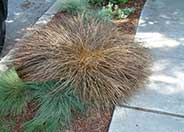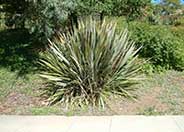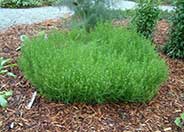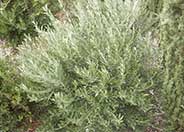
Common name:Blue Fescue
Botanical name:Festuca glauca
This ground cover/grass will grow less than 1' tall and has small, blue green leaves.
Maintenance Tips
Festuca glauca is a perennial clump-forming grass. It has soft straw-like leaves that form a blue-green dome that can get up to about 10 inches wide and tall. They prefer full sun and well-drained soil, but can tolerate slight shade, drought conditions, and poor soil nutrition. These will send out flower stalks in the summer, which should be cut back to the base after a few months to give them a cleaner appearance. They will also benefit from having any dead leaves pulled from the plant at any time of year, but the fall is typically the best time to clean up the foliage. It is short-lived in the landscape, with a lifespan of about 2-4 years after which it dies out in the center. Some might dig up and divide the living edges into several new plants, but most of the time it is easier to replace with a new one.
Common name:Curly Top Sedge
Botanical name:Carex buchananii
This orange bronze ornamental grass/reed is 2'-3' tall and 1'-2' wide and does best in full sun to part shade.

Common name:Beach Strawberry, Coastal Strawberr
Botanical name:Fragaria chiloensis
This perennial grows 4"-8" high with tooth-edged leaves and ornamental strawberries during the fall. Cut back or mow in early spring to encourage new growth.
Maintenance Tips
Fragaria chiloensis is a lovely ground cover that is also known as Coastal Strawberry. It is a very well-behaved ground cover, requiring very little maintenance to keep it looking and performing its best. It is best known for its berries which are very attractive to birds and other wildlife. The plant rarely grows taller than 4-6" and spreads out through its root system, creating a dense mat. The plant is susceptible to many types of fungi because of the moisture and the lack of airflow in its dense environment. Treating the plant with a systemic or topical fungicide may be necessary if the infection is killing the plant. Thatching the ground cover and drying the area out can help control fungal issues as well.
Common name:New Zealand Flax
Botanical name:Phormium tenax
New Zealand Flax is a large, bold plant with stiffly vertical, sword-like, green leaves that arise from its base. It should be grown under full sun for best color. Varieties will offer different growth habits and leaf color.
Maintenance Tips
Phormium tenax is a perennial that grows as a clump with strap-like leaves. This is a very popular plant and has many different hybrids that are selected for their different foliage colors, sizes, and textures. When growing this species, there is a lot of genetic variety, so the size of the mature plant can range from 2' up to 8'. To keep the maintenance as low as possible, plant in a location that is full sun, and well-drained and give it the space it needs to reach maturity. These plants are often the victim of poor pruning habits, with gardeners cutting the leaves off in the middle or shearing them because they are too large for the space they have been given. If this is the case, they should be transplanted to a location where they can reach their full size, or other plants around them should be moved out of their way.
Common name:Green Lavender Cotton
Botanical name:Santolina rosmarinifolia
Santolina is an amazingly tough plant with small, yellow, button-sized flowers that cover the 3' tall and 3' wide shrub in the summer months. The green leaves are very thin and needle like. This plant requires absolutely no care in most environments once established. Too much water will lead to mortality. Best grown in well drained soils.

Common name:Little Ollie Dwarf Olive
Botanical name:Olea europaea 'Little Ollie'
This evergreen shrub will grow to 8' tall and doesn't produce any fruit. It will do well in hot dry areas but can also survive in coastal areas.
Photographer: GardenSoft
Practice grass-cycling by leaving short grass clippings on lawns after mowing, so that nutrients and organic matter are returned to the soil.
Drip and other smart irrigation delivers water directly to roots, allowing no excess water for weeds.